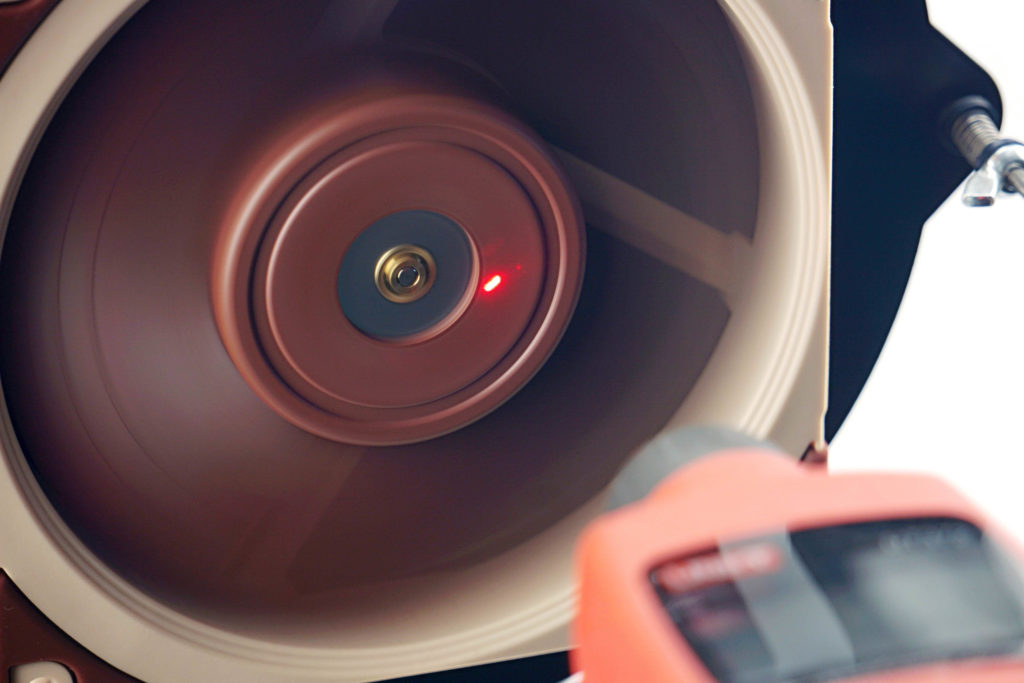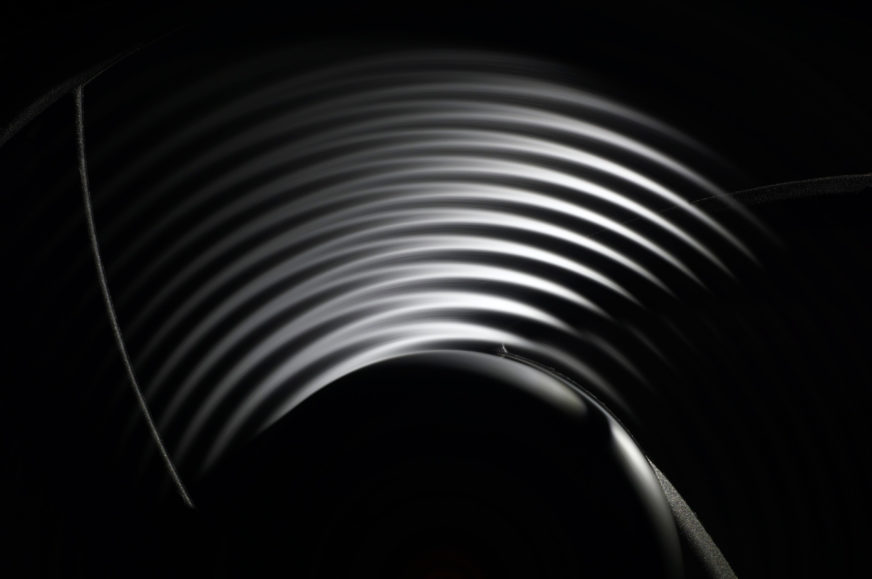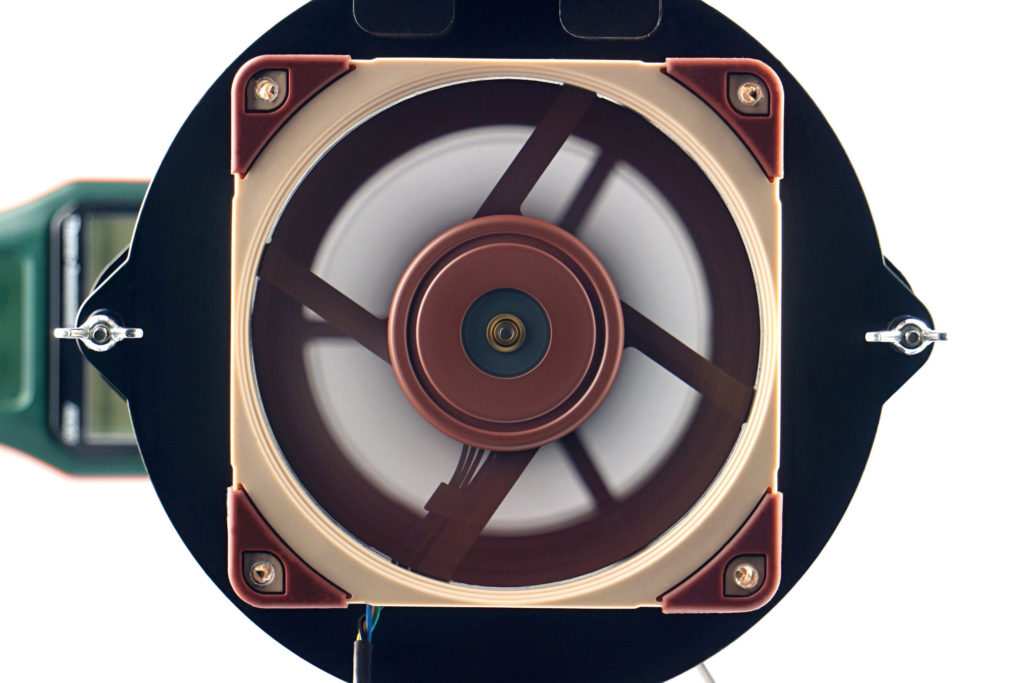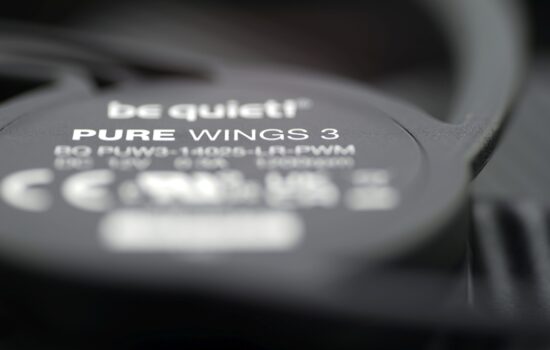Initial warm-up and speed recording
To write that we have something mapped out to the last detail is perhaps too bold, but after proper preparation, few pieces of hardware are as easy to evaluate as fans. Of course, this had to be preceded by long preparations, developing a methodology, but you already know the story. What you don’t know yet is the first fruit, or rather the results of Akasa, SilentiumPC, SilverStone, Xigmatek or more exotic Reeven fans.
Initial warm-up…
Before we even start measuring anything, we let the fans run “idle” for a few minutes after plugging them in. This is because immediately after a cold start the fans reach different parameters than after a certain amount of short-term operation.
Until the operating temperature of the lubricant is stabilized, a typically lower maximum performance is achieved. This is because at lower temperatures the lubricant is denser, which is associated with higher friction. Therefore, the fans do not reach maximum speed immediately, but only after the first few seconds. Before the first measurements, we therefore leave the fans running for at least 300 seconds at 12 V, or 100 % PWM intensity.
…and speed recording
The speed of the fans is monitored using a laser tachometer, which reads the number of revolutions from a reflective sticker on the rotor. For this purpose, we use the UNI-T UT372 device, which also allows real-time averaging of samples. Thus, we do not record the peak value in the graphs, but the average speed value from a 30-second time period.
However, the speed itself is a relatively unimportant parameter that is often given more attention than is appropriate. This is the case even in many fan or cooler tests, where speed is used to normalize the different modes in which other variables are measured.

However, hyper-focusing on a specific speed is a rather unfortunate decision if only because the fans don’t gain any commonality. At the same speed all other variables are different, there is no intersection. It can be noted that a better normalization would have been by any other variable, whether it be static pressure, flow or noise level, which wins in our case. But more on that in the next chapter.
We only measure the speed so that you can associate a particular parameter (such as the amount of static pressure or some noise level) with something according to which you can adjust the fan yourself. Perhaps for that alone, the information about the achieved speed is useful. As part of the fan analysis, we will also indicate what the fans’ starting and minimum speeds are. Start-up speeds tend to be higher than minimum speeds because more force is required to get the rotor moving than once the fan rotor is spinning, and a minimum power intensity is sought at which the fan does not stall.
- Contents
- BeQuiet! Silent Wings 3 (BL066) in detail
- The basis of the methodology, the wind tunnel
- Mounting and vibration measurement
- Initial warm-up and speed recording
- Base 7 equal noise levels…
- .. and sound color (frequency characteristic)
- Static pressure measurement…
- … and airflow
- Everything changes with obstacles
- How we measure power draw and motor power
- Measuring the intensity (and power draw) of lighting
- Results: Speed
- Results: Airlow w/o obstacles
- Results: Airflow through a nylon filter
- Results: Airflow through a plastic filter
- Results: Airflow through a hexagonal grille
- Results: Airflow through a thinner radiator
- Results: Airflow through a thicker radiator
- Results: Static pressure w/o obstacles
- Results: Static pressure through a nylon filter
- Results: Static pressure through a plastic filter
- Results: Static pressure through a hexagonal grille
- Results: Static pressure through a thinner radiator
- Results: Static pressure through a thicker radiator
- Results: Static pressure, efficiency by orientation
- Reality vs. specifications
- Results: Frequency response of sound w/o obstacles
- Results: Frequency response of sound with a dust filter
- Results: Frequency response of sound with a hexagonal grille
- Results: Frequency response of sound with a radiator
- Results: Vibration, in total (3D vector length)
- Results: Vibration, X-axis
- Results: Vibration, Y-axis
- Results: Vibration, Z-axis
- Results: Power draw (and motor power)
- Results: Cooling performance per watt, airflow
- Results: Cooling performance per watt, static pressure
- Airflow per euro
- Static pressure per euro
- Results: Lighting – LED luminance and power draw
- Results: LED to motor power draw ratio
- Evaluation













I have this fan as a part of the Dark Rock Pro 4 cooler – the front one. The inner fan is disabled for now. Unfortunately, I am thinking about replacing it. What’s driving me completely nuts is the fan start that gives a sound resembling powerful rubbing against a rough surface. It’s okay for folks who want to have the fan running constantly and encounter it only during boot but I want to have a fanless idle – 0 noise, no vibrations, extended fan life, and lower power draw. I wish such behavior was stressed in this and other reviews so that one can find safe alternatives for such requirements.
It’s a pity to encounter such an unexpected drawback, as this fan is much quieter than Arctic P12. At 700 RPM, it’s barely audible in my Nanoxia Deep Silence 8 in the night, and below 500 RPM basically inaudible.
What you are describing is happening with several fans. To an excessive degree with the Strix XF120 as well, where we also mentioned it. I have thought about how to measurably grasp those starts in the context of the interpretation of the results so that a simple comparison across fans is possible, but I don’t know yet.. anyway, it will probably be an initial phase with rotor centering, which is accompanied by higher vibrations in addition to the acoustic expression.
Perhaps the evaluation page can be divided into several labelled subsections, one being dedicated to observations like this for example.
My P14 Slim rev.1 does this initially too, but it’s gone now after I have mounted it tight. Perhaps quality control and tolerance also play a role here?
Maybe we are each talking about a slightly different phenomenon. The initial, let’s say start-up sound of Strix XF120 will certainly not be influenced by the strength of the mounting. With this fan, it’s just that it takes some time (be it very short, in the lower units of seconds) to get centered, and the operational sound is probably a bit different after, let’s say, warming up. I would attribute this purely to the influence of the motor and the bearings. In this case, I would not talk about an issue of a single unit in serial production. Sure, within lower manufacturing tolerances some minor differences in behaviour can be present, but if that feature disappeared completely, I assume it would be due to larger, targeted changes in the design, which for example are solved by various revisions. Unfortunately, most manufacturers don’t talk about them, with a few exceptions (Arctic, for example). So sure, a Silent Wings 3 from the early batches may behave differently than the latest pieces from the current sales. And while we’re on the subject of fan differences from piece to piece, we’ll release one unconventional test in September that will be of interest to you. 🙂
I would rather attribute the different sound after tightening the P14 rev. 2 to vibrations and the fact that with a different mounting there may not be such significant resonance frequencies of the case.